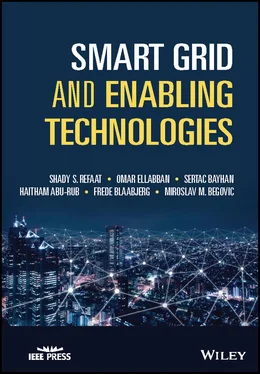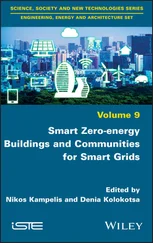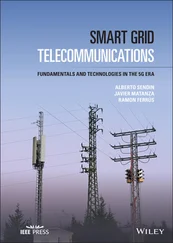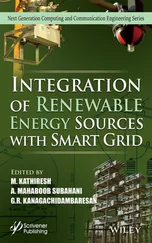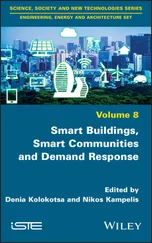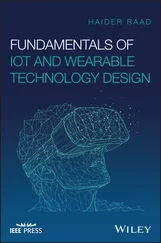Frede Blaabjerg - Smart Grid and Enabling Technologies
Здесь есть возможность читать онлайн «Frede Blaabjerg - Smart Grid and Enabling Technologies» — ознакомительный отрывок электронной книги совершенно бесплатно, а после прочтения отрывка купить полную версию. В некоторых случаях можно слушать аудио, скачать через торрент в формате fb2 и присутствует краткое содержание. Жанр: unrecognised, на английском языке. Описание произведения, (предисловие) а так же отзывы посетителей доступны на портале библиотеки ЛибКат.
- Название:Smart Grid and Enabling Technologies
- Автор:
- Жанр:
- Год:неизвестен
- ISBN:нет данных
- Рейтинг книги:3 / 5. Голосов: 1
-
Избранное:Добавить в избранное
- Отзывы:
-
Ваша оценка:
- 60
- 1
- 2
- 3
- 4
- 5
Smart Grid and Enabling Technologies: краткое содержание, описание и аннотация
Предлагаем к чтению аннотацию, описание, краткое содержание или предисловие (зависит от того, что написал сам автор книги «Smart Grid and Enabling Technologies»). Если вы не нашли необходимую информацию о книге — напишите в комментариях, мы постараемся отыскать её.
Smart Grid and Enabling Technologies
Smart Grid and Enabling Technologies
Smart Grid and Enabling Technologies — читать онлайн ознакомительный отрывок
Ниже представлен текст книги, разбитый по страницам. Система сохранения места последней прочитанной страницы, позволяет с удобством читать онлайн бесплатно книгу «Smart Grid and Enabling Technologies», без необходимости каждый раз заново искать на чём Вы остановились. Поставьте закладку, и сможете в любой момент перейти на страницу, на которой закончили чтение.
Интервал:
Закладка:
4 Chapter 4Figure 4.1 An electrical energy storage (EES) system structure (a) and energ...Figure 4.2 Classification of electrical energy storage technologies accordin...Figure 4.3 Electrical energy storage technologies classification according t...Figure 4.4 Maturity of electrical energy storage technologies.Figure 4.5 Global Grid‐Connected Energy Storage Capacity, by Technology, 201...Figure 4.6 Electricity storage technologies comparison – discharge time vs p...Figure 4.7 Self‐discharge and suggested storage period of energy storage sys...Figure 4.8 Comparison of power density and energy density of energy storage ...Figure 4.9 Energy storage technologies capital cost, 2018.Figure 4.10 Levelized cost of storage (LCOS) for different technologies, 201...Figure 4.11 Typical cycle efficiency (max. and min.) of energy storage syste...Figure 4.12 Energy Stored on Energy Invested (ESOI) ratios of different ener...Figure 4.13 Cost calculation for energy storage system. Ref Num [39]. Reprod...Figure 4.14 An example for optimal allocation procedure of ESS in distributi...Figure 4.15 Selected services of energy storage systems with the correspondi...Figure 4.16 Typical grid energy storage applications at different voltage le...Figure 4.17 Energy Storage main deployment barriers.
5 Chapter 5Figure 5.1 The simplified single‐line diagram of a microgrid.Figure 5.2 Typical configuration of the DG units with (a) LVAC network; (b) ...Figure 5.3 AC microgrid structure with DG units and mixed types of loads.Figure 5.4 Concept of a DC microgrid system with the DG units and mixed type...Figure 5.5 PV solar power modules price learning curve for different technol...Figure 5.6 The hierarchical control structure of the microgrid. Adapted from...Figure 5.7 The simplified single‐line diagram and DG structure of microgrid ...Figure 5.8 P/ω and Q/E droop characteristics [8]. Reproduced with permission...Figure 5.9 The simplified control scheme of traditional droop control for DG...Figure 5.10 Comparison of traditional and opposite droop characteristics.Figure 5.11 General structure of centralized and decentralized control appro...Figure 5.12 Control and management architecture of a multi‐microgrid system....Figure 5.13 An overview of micro grid benefits Ref [67]. Reproduced with per...
6 Chapter 6Figure 6.1 Global sales of electric cars (BEV and PHEV) by year.Figure 6.2 The typical powertrain configuration of series HEV.Figure 6.3 The typical powertrain configuration of parallel HEV.Figure 6.4 The typical powertrain configuration of series–parallel HEV.Figure 6.5 The simplified block diagram of battery charger.Figure 6.6 EV charging configuration at (a) AC Level 1 and 2 setups; (b) DC ...Figure 6.7 The general structure of wireless power transfer technology for E...Figure 6.8 Concepts of (a) static WPT system; and (b) dynamic WPT system.Figure 6.9 The general structure of V2G, V2H, and V2V concepts in power syst...Figure 6.10 The typical bidirectional power converter topology for bidirecti...Figure 6.11 Technological, social, and economic problems of EVs.
7 Chapter 7Figure 7.1 The net‐Zero Energy Concept (nZEC). Adapted from Ref Num [2].Figure 7.2 Net Zero Energy Building (nZEB) overview and relevant terminology...Figure 7.3 The nZEB balance concept. Ref Num [4]. Reproduced with permission...Figure 7.4 nZEB main design elements.Figure 7.5 Main design elements for the nZEB.Figure 7.6 Fully integrated nZEB energy management system. Adapted from Ref ...Figure 7.7 Utilization share of major simulation programs in building optimi...Figure 7.8 Renewable energy system size Multi‐objective design optimization....Figure 7.9 Net Zero Energy Community: general overview.Figure 7.10 Global building efficiency revenue, 2011–2018.
8 Chapter 8Figure 8.1 Evolution of electricity metering.Figure 8.2 Illustration of typical smart meter systems.Figure 8.3 Architectural model of smart meter system.Figure 8.4 Smart meter security objectives. Ref Num [6]. Reproduced with per...Figure 8.5 SG communication: a hierarchical structure with three major netwo...
9 Chapter 9Figure 9.1 Basic information layer of SG.Figure 9.2 Basic communication layer. Adapted from Ref Num [5].Figure 9.3 Resilient control system framework.Figure 9.4 Percentage of attacks on grid components. Ref Num [15]. Reproduce...Figure 9.5 Main security objectives in SG. Adapted from Ref [24].Figure 9.6 Relation between cyber threats and SG cyber requirements. Adapted...Figure 9.7 Common sources of cyber‐attacks. Adapted from Ref [34].Figure 9.8 Impact of attacks on the power grid.Figure 9.9 Cyber incidents percentages in 2017.
10 Chapter 10Figure 10.1 Data sources used by SG.Figure 10.2 Pattern of big data volume in electric utilities. Adapted from R...Figure 10.3 Big Data architecture and patterns.Figure 10.4 Big data process.Figure 10.5 An approach to develop a platform‐oriented analytical architectu...Figure 10.6 Big Data V's.Figure 10.7 The path of SG. Adapted from Ref Num [33].Figure 10.8 Integrated analytics model to generate value.Figure 10.9 Meter data management.
11 Chapter 11Figure 11.1 Benefits of demand side management. Adapted from Ref [3].Figure 11.2 Demand response.Figure 11.3 Major features load response programs.Figure 11.4 Major features of price response programs.Figure 11.5 DR programs. Adapted from Ref [8].Figure 11.6 Clarification of the procedure of end‐user‐interaction defining ...Figure 11.7 A stylized interpretation.Figure 11.8 Major areas of dDSM.Figure 11.9 Relationships between DSM Table 11.1.1 Programs. Adapted from Re...Figure 11.10 Process evaluation of DSM.Figure 11.11 Major Research Studies worldwide. Ref [22]. Reproduced with per...
12 Chapter 12Figure 12.1 Conceptualization of the business model canvas.Figure 12.2 The business model framework used to understand the impact of SG...Figure 12.3 The traditional electricity value chain.Figure 12.4 The emerging electricity value chain with both power and informa...Figure 12.5 Structure of electricity trading for different time horizons.Figure 12.6 Market entities and their interactions in smart grid arena.Figure 12.7 The timing‐based business model and its created value for the SG...Figure 12.8 The business intelligence framework which can be applied to the ...Figure 12.9 Benefits of integrated energy services.Figure 12.10 Future business model levers for the SG. Ref [24]. Used with pe...Figure 12.11 Blockchain based electricity market [25].
13 Chapter 13Figure 13.1 Traditional electric power system structure.Figure 13.2 Concept of the SG – indicating physical and communication interc...Figure 13.3 Concept of prosumer on SG.Figure 13.4 Building blocks of the SG [22]. Reproduced with permission from ...Figure 13.5 The three pillars of the SG: smart marker; smart utility and sma...Figure 13.6 Different SG domains.Figure 13.7 The energy cultures conceptual framework.Figure 13.8 Theory of reasoned action.Figure 13.9 Theory of planned behavior.Figure 13.10 Theory of planned behavior model with resistance to change vari...Figure 13.11 Technology acceptance model.Figure 13.12 Technology acceptance model integrated with perceived risk.Figure 13.13 Technology acceptance model for SG with external variables set....Figure 13.14 Value‐based adoption model of technology.Figure 13.15 The three dimensions of the SG social acceptance, which are: ma...Figure 13.16 The innovation decision process in the SG arena.Figure 13.17 Factors affecting the rate of innovation adoption toward SG.Figure 13.18 Transtheoretical model – the process of change toward SG.Figure 13.19 The Fogg behavior model has three factors: motivation, ability,...Figure 13.20 SG expectation cycle [88]. Reproduces with permission from Pric...Figure 13.21 Energy providers‐consumer new relationships focus areas in SG....
14 Chapter 14Figure 14.1 The relationship between SG, cloud computing, and big data.Figure 14.2 Cloud computing model essential characteristics.Figure 14.3 Cloud computing layers.Figure 14.4 Three forms of the clouds; Public, Private, or Hybrid clouds.Figure 14.5 Workload distribution architecture.Figure 14.6 Cloud bursting architecture.Figure 14.7 Dynamic scalable architecture.Figure 14.8 Elastic resource capacity architecture.Figure 14.9 Cloud computing platform coupled with SG.Figure 14.10 Various SG applications supported by cloud.Figure 14.11 SG with and without cloud computing.Figure 14.12 The cloud computing characteristics.Figure 14.13 Cloud computing opportunities and challenges for smart grid.Figure 14.14 Major categories of data security challenges.
Читать дальшеИнтервал:
Закладка:
Похожие книги на «Smart Grid and Enabling Technologies»
Представляем Вашему вниманию похожие книги на «Smart Grid and Enabling Technologies» списком для выбора. Мы отобрали схожую по названию и смыслу литературу в надежде предоставить читателям больше вариантов отыскать новые, интересные, ещё непрочитанные произведения.
Обсуждение, отзывы о книге «Smart Grid and Enabling Technologies» и просто собственные мнения читателей. Оставьте ваши комментарии, напишите, что Вы думаете о произведении, его смысле или главных героях. Укажите что конкретно понравилось, а что нет, и почему Вы так считаете.
